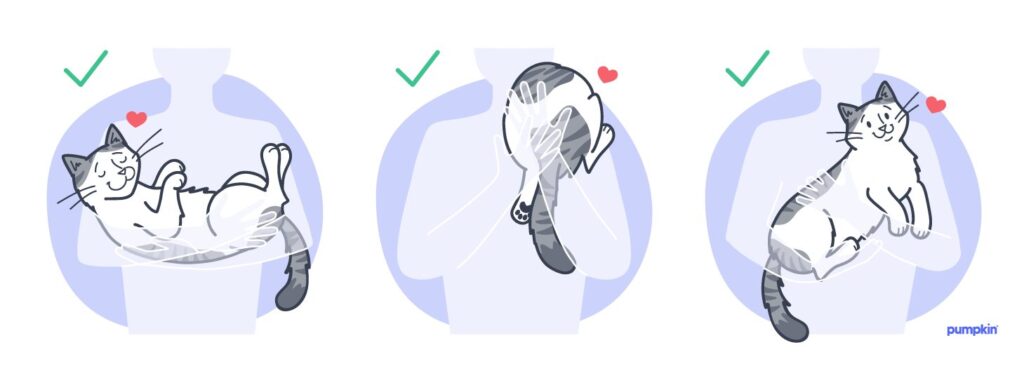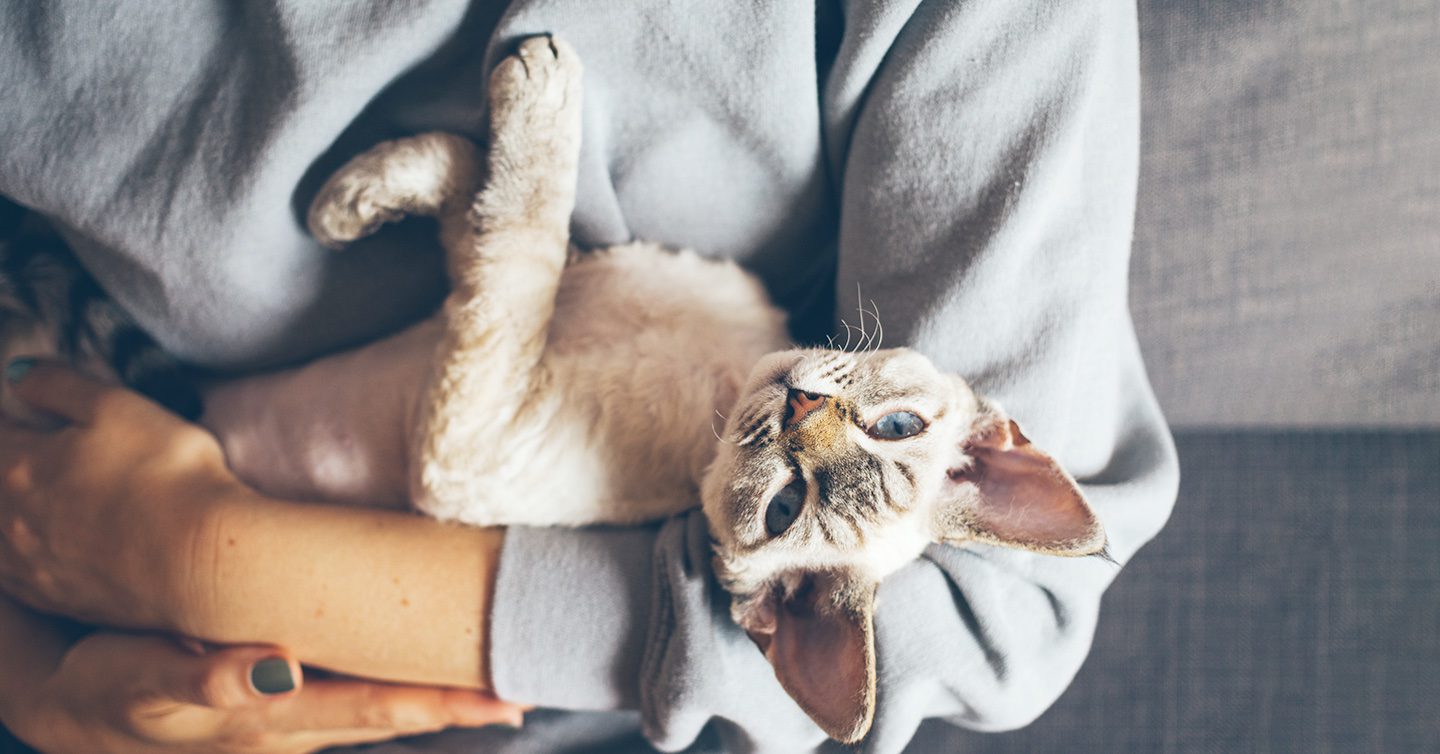Key Points
- Before picking up your cat, approach them slowly and get a read on their body language.
- Be sure to keep a firm yet gentle grip on their chest, abdomen and back legs so they’re not dangling.
- Hold your cat close to your body. Gently squishing them against your chest may help them feel more secure.
While cats love to cuddle and tend to enjoy human interaction, cats don’t always want to be held. Especially in moments of stress or anxiety, cats can be fickle, hard to grasp, and may even slip right out of your hands.
This is why it’s especially important to understand the right (and wrong) ways to hold a cat. Read on for expert advice on how to safely hold your cat.
How to safely hold a cat
According to certified cat behaviorist Dr. Janet Cutler, the most important thing to remember when holding a cat is to keep them supported yet unrestrained.
“You want to make sure that your cat feels supported when holding them, so try not to let their legs dangle if holding them in your arms,” she says. “You can place your hand gently on their back to help keep them in your arms. If your cat is on a table, the floor, or another surface, using the minimum amount of restraint you need to is advised – holding their shoulders so they can’t get away, but allowing them to move their head, body, and legs. If they are very stressed, it might be useful to have them in a carrier to make sure that no one gets injured.”
Step-by-step instructions on holding a cat
- Make them aware of your presence: Cats can spook easily, so before you attempt to pick one up, be sure they’re aware of your presence. Hand sniffs, gentle pats on the back, and even announcing your intention to pick them up will help prepare your cat for what’s to come. Watch your cat’s body language for clues as to how they’re feeling. If they’re purring when you approach, chances are it’s okay to lift them up in the air.
- Position your cat: Set your cat up to be lifted by placing one hand under their chest or abdomen and one under their legs. Be sure to have a firm yet gentle grasp on your cat’s chest, front legs, and back legs, so they can’t squirm out of your arms.
- Lift your cat: After you’ve placed your dominant hand under your cat’s chest and your supporting hand on their hind legs, lift your cat with confidence. Use strong and reassuring movements when lifting your cat up to signify steadiness to your cat. Once you lift them up, hold your cat close to your chest.
- Support your cat: Cats tend to feel safe when they’re held tightly. Gently squishing them into your body will help them feel supported and secure. However, don’t be so restrictive in your hold that they can’t look around at their surroundings.

What not to do when picking up a cat
While scruffing aka grabbing the loose skin around a cat’s neck was once considered a safe way to handle a cat, many veterinarians now argue against this method. According to this 2020 study, cats respond rather negatively to scruffing and full-body restraint. Dr. Janet Cutler advises against these tactics, explaining that scruffing will only stress your cat out.
“Researchers have found that scruffing your cat and full-body restraint (i.e. lying your cat on their side and holding their legs) has been shown to be quite stressful, so using the minimum amount of restraint is usually best for most cats,” she says.
Rather than immobilizing your cat completely when trying to pick them up, you should always allow them some autonomy over their body. Cats like to be able to move their head to keep track of their surroundings, which can be restricted by scruffing. Even though scruffing is a common practice among a mother cat and her kittens, you should leave the scruff of your adult cat alone when attempting to hold them.
Handling cats in stressful situations
Cats will certainly let you know if and when they’re upset and do not want to be held. But sometimes, regardless of their wishes, there are moments that require a cat to be picked up.
When it comes to safe cat restraint, you can gently squish them down against the surface you plan to pick them up from. Pressing your cat down in this way will not only prevent them from escaping out of your grasp, but it will also help make your cat feel more comfortable and secure in moments of distress.
“It’s important to pick up your cat gently if they’re getting into mischief, and put them somewhere safe and give them something else to do,” says Dr. Cutler. “Yelling or punishing your cat will simply damage the bond between you and your cat and can make them scared of you, but likely won’t have any impact on the mischief they were getting themselves into.”
Coercing your cat into a cat carrier
Generally speaking, cats will not go into a carrier on their own accord. It takes time, practice, and lots of patience to get your cat in their travel carrier. But before you scoop your cat up and force them into a carrier, Dr. Cutler recommends leaving the carrier out before you plan to leave so your cat can get acquainted with it.
“Try having the crate out and allowing your cat to explore it, with some treats inside for added encouragement,” suggests Dr. Cutler. “You can also reward your cat with treats for going inside. Once they’re comfortable going in and out, give them a treat when they’re inside and practice closing the door for very short periods of time.”
Importantly, Dr. Cutler advises against forcing your cat into a carrier. “It’s best to avoid forcefully putting your cat into the crate and closing it, as this can cause negative associations with going into the travel crate,” she explains.
If you’re a cat owner, it’s important to learn how to hold a cat the right way. Whether you want to scoop them up for some cuddles or need to get them out of a distressing situation, always be sure to pay close attention to your cat’s body language, hold them close to your body, and keep a firm yet gentle grasp on their chest and hind legs.




